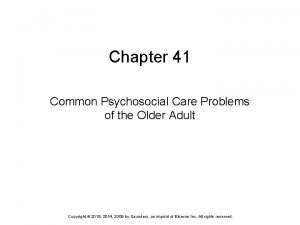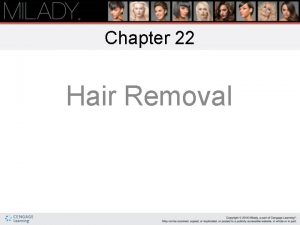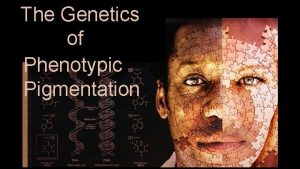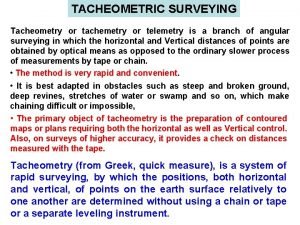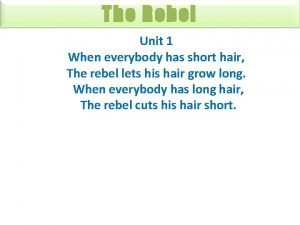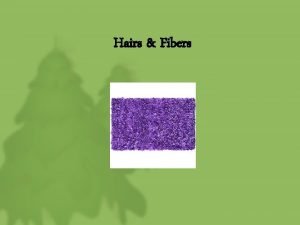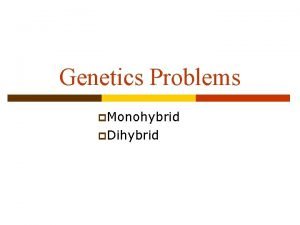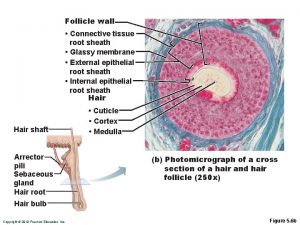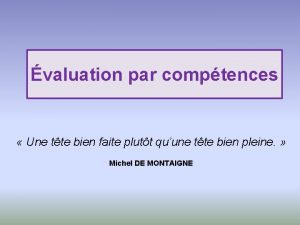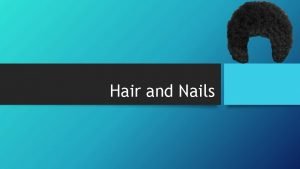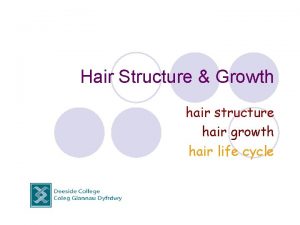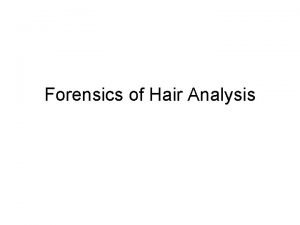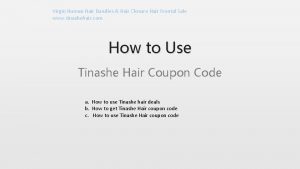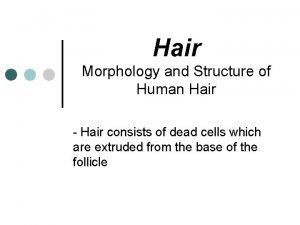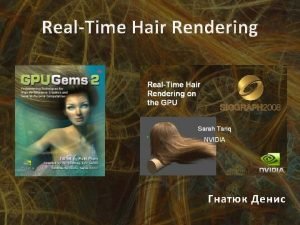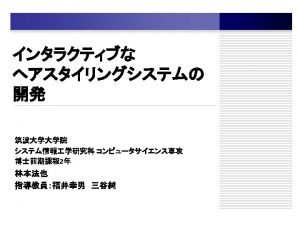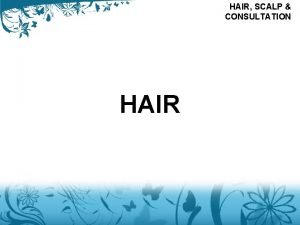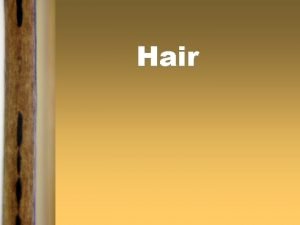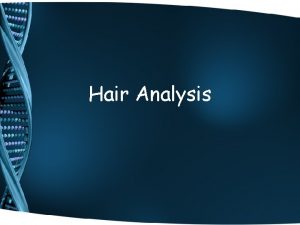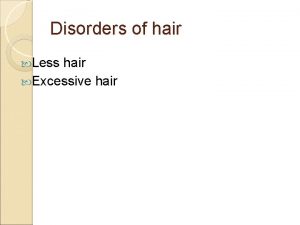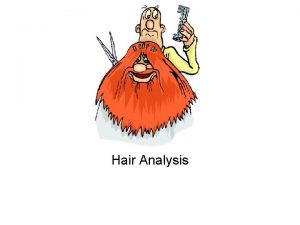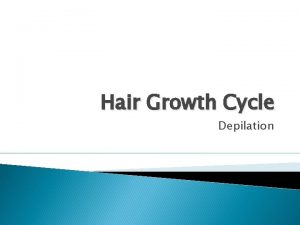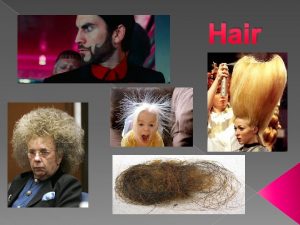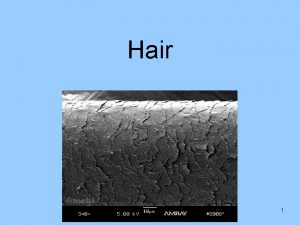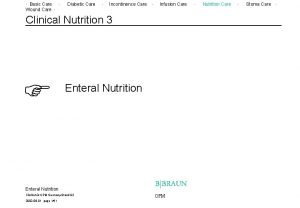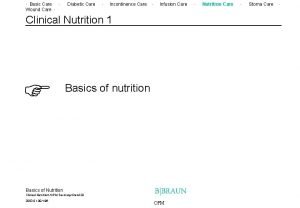7 2 HAIR CARE HAIR EVALUATION COMMON HAIR






























- Slides: 30

7. 2 HAIR CARE HAIR EVALUATION COMMON HAIR CONDITIONS COMMON SCALP CONDITIONS HAIR LOSS CHAPTER 7 TRICHOLOGY | HAIR CARE | ADVANCED ORGANIZER

FOLLOWING THIS LESSON, YOU WILL BE ABLE TO: • Recognize how to care for hair by doing an evaluation for common hair disorders including hair loss CHAPTER 7 TRICHOLOGY | ADVANCE ORGANIZER

HAIR EVALUATION 1. DETERMINE CLIENT’S HAIR TYPE AND DENSITY Texture: degree of coarseness or fineness in the hair fiber FINE: FEEL OF SILK MEDIUM: FEEL OF COTTON CHAPTER 7 TRICHOLOGY | HAIR CARE COARSE: FEEL OF WOOL

• Perform a visual examination to provide clues on the condition of the client’s hair • Ask client questions to determine which products will work best CHAPTER 7 TRICHOLOGY | HAIR CARE

Density: number of active hair follicles per square inch on the scalp Thin Medium Thick density requires smaller subsections than thin hair to allow for absorption of styling and processing lotions. CHAPTER 7 TRICHOLOGY | HAIR CARE

2. DETERMINE CLIENT’S HAIR CONDITION TWO HAIR CONDITION FACTORS: • Porosity • Elasticity CHAPTER 7 TRICHOLOGY | HAIR CARE

Porosity: ability of hair to absorb moisture, liquids or chemicals • Resistant – absorbs least amount of moisture • Average – normal ability to absorb moisture • Extreme – not in good condition • Uneven – combination of two or more porosities CHAPTER 7 TRICHOLOGY | HAIR CARE

Elasticity: ability of hair to stretch and return to original shape without breaking • Normal dry hair is capable of stretching 1/5 (20%) of its length • Wet hair is able to be stretched 40% to 50% of its length CHAPTER 7 TRICHOLOGY | HAIR CARE

TEST FOR STRUCTURAL STRENGTH • Remove strand of hair • Hold between thumb and forefinger; run the distance of the hair • Pull hair taut for 10 seconds; release • Normal hair stretches one-fifth (20%) of its length • Wet hair stretches 40%-50% of its length Good CHAPTER 7 TRICHOLOGY | HAIR CARE Weak

3. CONSIDER EFFECTS OF CLIMATE The amount of moisture in air determines amount of moisture in hair • In humid regions curl retention is a challenge • In dry regions hair tends to be flyaway CHAPTER 7 TRICHOLOGY | HAIR CARE

COMMON HAIR CONDITIONS • The hair strand has about 7 to 12 layers of cuticle scales that protect the inside of the strand (the cortex). • The scales should lie flat along the cortex in healthy hair. • The acid mantle lubricates the outermost layer of the cuticle and reduces friction. • Combing and brushing may cause friction that damages the cuticle. CHAPTER 7 TRICHOLOGY | HAIR CARE

CONDITION TECHNICAL TERM DESCRIPTION Broken Hair Abraded Hair Raised cuticle due to excess stretching or traction Split Ends Fragilitus Crinium; Brittle Hair or Trichoptilosis Small cracks in the cuticle that deepen into the cortex Matting Pilica Polonica Mass of hair strands tangled together that cannot be separated Nodules Trichorrhexis Nodosa or Knotted Hair Lumps or swelling along hair shaft CHAPTER 7 TRICHOLOGY | HAIR CARE

CONDITION TECHNICAL TERM DESCRIPTION Grayness Canities Loss of pigment in the hair; grayness or whiteness; congenital or acquired Bands of Color Ringed Hair Alternating bands of gray and dark hair Hypertrichosis Hirsuties or Superfluous Hair Abnormal coverage of hair on areas of the body where normally only lanugo or babyfine hair appears Beaded Hair Monilethrix Breaks in the hair between beads or nodes CHAPTER 7 TRICHOLOGY | HAIR CARE

MECHANICAL DAMAGE Results from incorrect use of salon tools, e. g. , dryer used too close to the hair or curling iron left on too long NORMAL CORTEX CHAPTER 7 TRICHOLOGY | HAIR CARE MELTED CORTEX

DISORDER MEDICAL DESCRIPTION COMMON OR DISEASESCALP TERM CONDITIONS Silvery Scales Disorder Psoriasis Thick, crusty patches of red irritated scalp resulting from an autoimmune disease of the skin Dandruff Disorder Pityriasis Chronic scalp condition with excessive flaking, as well as itchiness, tightness, and irritation of the scalp Dry Dandruff Disorder Pityriasis Capitis Simplex Dry flakes attached to the scalp or on the hair, which can appear translucent Greasy or Waxy Dandruff Disorder Pityriasis Steatoides Oily flakes combine with sebum which stick to the scalp in clusters; yellowish in color CHAPTER 7 TRICHOLOGY | HAIR CARE

DISORDER OR DISEASE MEDICAL TERM DESCRIPTION Ringworm Disease Tinea Red, circular patch of blisters; caused by vegetable parasite Ringworm of the Scalp Disease Tinea Capitis Enlarged open hair follicles that are surrounded by clusters of red spots; hair is likely to break; black spots may be visible Honeycomb Ringworm Disease Tinea Favosa or Favus Dry, yellow encrusted areas on the scalp called scutula; may have an odor; shiny pink or white scars may result Itch Mite Disorder Scabies Red and watery vesicles or pus-filled areas caused by animal parasite burrowing under the skin Head Lice Disorder Pediculosis Capitis Infestation of head lice on the scalp causing itching and eventual infection CHAPTER 7 TRICHOLOGY | HAIR CARE

HAIR LOSS NORMAL HAIR LOSS • Lanugo: fine, silky hair covering body before birth • Vellus: short, fine, non-pigmented hair that replaces lanugo hair • Terminal: long, thick pigmented hair such as scalp and eyebrow hair Average Daily Hair Loss = 40 to 100 Strands CHAPTER 7 TRICHOLOGY | HAIR CARE

ANDROGENETIC HAIR LOSS Alopecia: excessive hair loss caused by fungal or bacterial infection or inflammatory disease of scalp • Suggest client see dermatologist if scalp appears abnormal Androgenetic alopecia: combination of heredity, hormones and age causes progressive shrinking, or miniaturization, of certain scalp follicles • Is most common form of alopecia • Known as male-pattern baldness or thinning of hair in females CHAPTER 7 TRICHOLOGY | HAIR CARE

ANDROGENETIC HAIR LOSS RECOGNIZING ANDROGENETIC ALOPECIA To analyze hair loss for male clients: • Ask if size of bald spot has progressively increased • Ask if hairline has been progressively receding • It is important to evaluate pattern separately from density CHAPTER 7 TRICHOLOGY | HAIR CARE

ANDROGENETIC HAIR LOSS RECOGNIZING ANDROGENETIC ALOPECIA To analyze hair loss for female clients: • Hold an index card near scalp to help see the miniaturized hairs • Check width of part line • Review the size of ponytail over the years • Inquire about amount of hair left in brush or in drain after shampooing CHAPTER 7 TRICHOLOGY | HAIR CARE

ANDROGENETIC HAIR LOSS The degree of hair loss can be evaluated by rating pattern and density: • Pattern refers to shape and location of area • Density refers to how much hair is covering the scalp in the area of hair loss CHAPTER 7 TRICHOLOGY | HAIR CARE

OTHER TYPES OF HAIR LOSS Postpartum alopecia: temporary hair loss after childbirth Alopecia areata: sudden loss of hair; irregular patches Telogen effluvium: premature shedding of hair Traction or traumatic alopecia: hair loss from pulling or twisting CHAPTER 7 TRICHOLOGY | HAIR CARE

HAIR LOSS TREATMENT OF ANDROGENETIC ALOPECIA 1. FDA-approved products 2. Products that provide environments for hair regrowth 3. Surgical options 4. Wigs, toupees, hair additions, hair weaving 5. Cosmetic hair thickeners CHAPTER 7 TRICHOLOGY | HAIR CARE

SELF-CHECK On a sheet of paper numbered 1 -5, answer the following questions. 1. The ability of hair to absorb moisture, liquids or chemicals is called _____. 2. The ability of hair to stretch and return to its original shape without breaking is called _____. 3. Each hairstrand has about 7 to 12 layers of _____ scales. CHAPTER 7 TRICHOLOGY | HAIR CARE | SELF-CHECK

SELF-CHECK 4. Incorrect use of styling tools may cause _____ damage. 5. Normal hair loss consists of _____to _____ strands a day. CHAPTER 7 TRICHOLOGY | HAIR CARE | SELF-CHECK

SELF-CHECK On a sheet of paper numbered 1 -5, answer the following questions. 1. The ability of hair to absorb moisture, liquids or porosity chemicals is called _____. 2. The ability of hair to stretch and return to its original elasticity shape without breaking is called _____. 3. Each hairstrand has about 7 to 12 layers of _____ cuticle scales. CHAPTER 7 TRICHOLOGY | HAIR CARE | SELF-CHECK

SELF-CHECK 4. Incorrect mechanical use of styling tools may cause _____ damage. 40 hair loss consists of _____to 100 _____ strands a day. 5. Normal CHAPTER 7 TRICHOLOGY | HAIR CARE | SELF-CHECK

FACE THE FACTS HAIR EVALUATION ü Hair varies in texture: fine, medium, and coarse ü Hair varies in density: thin, medium and thick ü Hair varies in porosity: resistant, average, extreme and uneven ü Elasticity is the ability of hair to stretch and return to its original shape without breaking CHAPTER 7 TRICHOLOGY | HAIR CARE | FACE THE FACTS

FACE THE FACTS COMMON HAIR CONDITIONS ü Each hairstrand has about 7 to 12 layers of cuticle scales ü The cuticle layers protect the inside of the strand (the cortex) ü Friction may cause damage to cuticle by combing and brushing ü Mechanical damage results from incorrect use of styling tools CHAPTER 7 TRICHOLOGY | HAIR CARE | FACE THE FACTS

FACE THE FACTS COMMON SCALP CONDITIONS ü Some scalp conditions are contagious and require you to refer the client to a physician HAIR LOSS ü It is normal to lose 40 to 100 strands of hair a day üA variety of treatments for hair loss are possible CHAPTER 7 TRICHOLOGY | HAIR CARE | FACE THE FACTS
 Health care levels primary secondary tertiary
Health care levels primary secondary tertiary Mental health nursing process
Mental health nursing process Factors 0f 18
Factors 0f 18 Common anode and common cathode
Common anode and common cathode Factor tree for 72
Factor tree for 72 Factors of 54
Factors of 54 Factors of 18
Factors of 18 Highest common factors and lowest common multiples
Highest common factors and lowest common multiples Common psychosocial care problems of the elderly
Common psychosocial care problems of the elderly The most common form of hair removal in salons and spas is:
The most common form of hair removal in salons and spas is: Care certificate standard 3
Care certificate standard 3 Polii magnetului
Polii magnetului Palliative care vs hospice care
Palliative care vs hospice care Prin ce se înmulțesc mamiferele
Prin ce se înmulțesc mamiferele Care sunt simturile prin care sunt evocate
Care sunt simturile prin care sunt evocate Health and safety care certificate
Health and safety care certificate Hip fracture clinical care standard
Hip fracture clinical care standard Unit 2 equality diversity and rights
Unit 2 equality diversity and rights What are three different processes of the shampoo service
What are three different processes of the shampoo service Dark hair and blonde hair parents
Dark hair and blonde hair parents Tachemetry
Tachemetry When everybody has long hair the rebel
When everybody has long hair the rebel Hair grows in diagonal tubes called hair
Hair grows in diagonal tubes called hair Human vs animal hair
Human vs animal hair Heterozygous short-hair x heterozygous short-hair
Heterozygous short-hair x heterozygous short-hair Follicle diagram
Follicle diagram Hirsuities
Hirsuities According to wentling (1980), evaluation must do more than
According to wentling (1980), evaluation must do more than Web application firewall
Web application firewall Solution evaluation criteria
Solution evaluation criteria Modèle de grille d'évaluation des compétences
Modèle de grille d'évaluation des compétences








